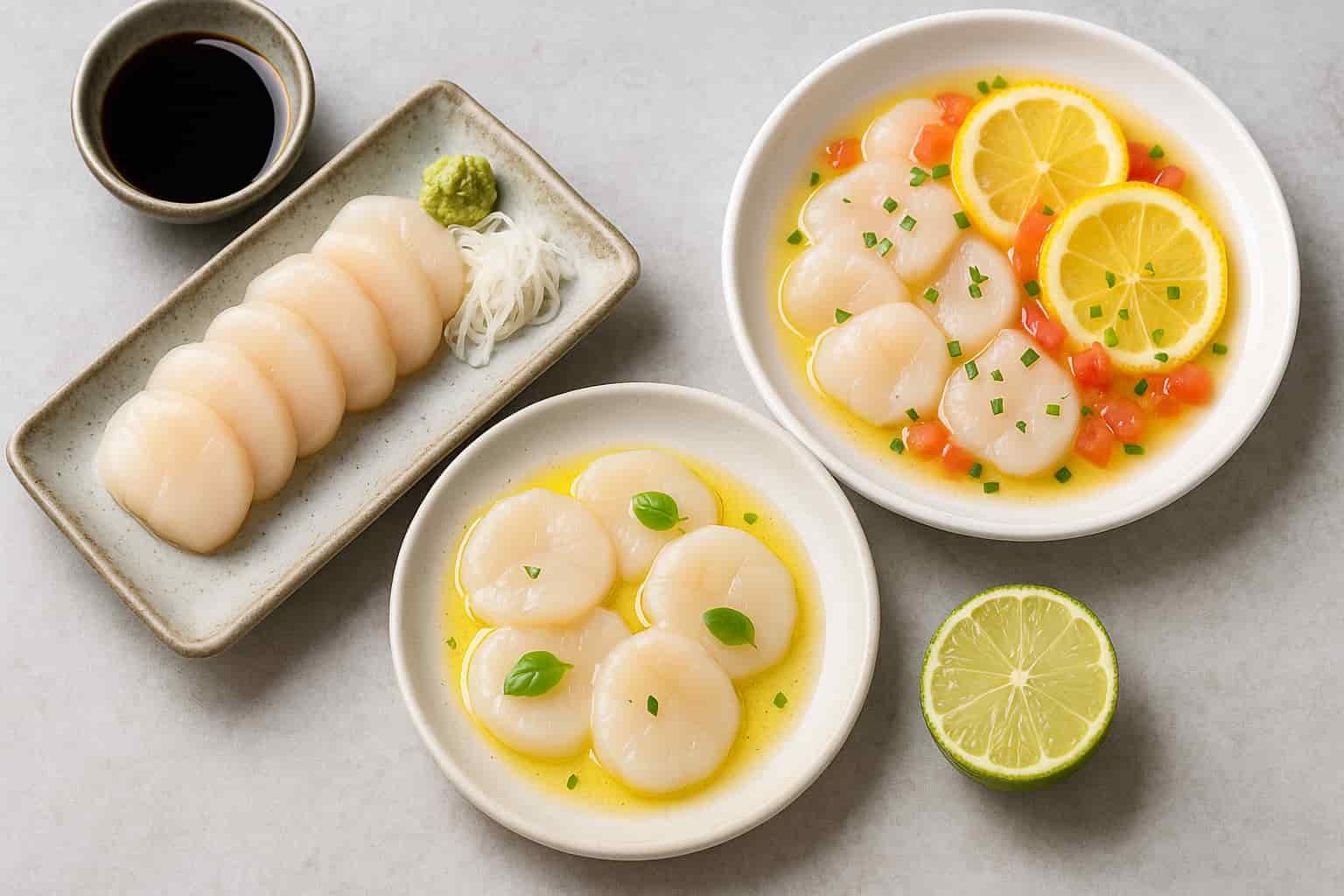Scallops are celebrated globally for their uniquely sweet, delicate flavor and buttery texture. While many culinary traditions prefer scallops cooked, enjoying them raw has become increasingly popular among seafood enthusiasts worldwide. From Japan’s minimalist sashimi approach that highlights their purity to the vibrant, citrus-infused ceviche in France, raw scallops offer a diverse culinary journey across continents. This article explores these global delicacies, guiding you through recipes, preparation techniques, and essential tips for safely savoring raw scallops in various international styles.
Contents
- 1 Why Raw Scallops? Exploring Freshness and Flavor
- 2 Japanese Sashimi: Purity in Simplicity
- 3 French Ceviche: A Twist of Citrus
- 4 Recipe Spotlight: Classic French Scallop Ceviche
- 5 South American Influence: Scallops Ceviche from Peru
- 6 Scallops Crudo: Italy’s Elegant Approach
- 7 Safety Tips for Eating Raw Scallops
- 8 Global Culinary Trends: Rising Popularity of Raw Seafood
- 9 Wrap-up
Why Raw Scallops? Exploring Freshness and Flavor
Raw scallops offer an unparalleled freshness and subtlety of flavor often masked by traditional cooking methods. Their taste is characterized by natural sweetness with a mild brininess reminiscent of the ocean itself. Eating scallops raw allows you to fully experience their buttery, tender texture and delicate sea-sweet aroma.
To enjoy scallops safely and deliciously, freshness is crucial. Scallops should be sushi-grade—meaning they’re meticulously handled, stored at optimal temperatures, and sourced from trusted suppliers. High-quality raw scallops present a translucent, slightly glossy appearance with a fresh oceanic smell. Any signs of discoloration, strong odors, or a slimy texture indicate spoilage, making them unsafe for raw consumption.
For detailed safety guidelines, be sure to check our comprehensive guide: Can You Eat Scallops Raw? Safety, Taste & How to Enjoy Them.
Japanese Sashimi: Purity in Simplicity
Japanese sashimi represents the pinnacle of seafood simplicity and elegance, emphasizing the pristine quality of raw ingredients above all else. Scallop sashimi, known in Japan as Hotate, is especially beloved for its sweet, clean flavor and luxuriously soft texture.
Traditional Japanese sashimi preparation requires precise knife skills. Scallops are thinly sliced to enhance their texture and maximize surface area for subtle flavors to shine through. Typically served on a chilled plate, raw scallops pair perfectly with a small dollop of fresh wasabi, shoyu (soy sauce), and daikon radish garnish.
In Japan, scallops from the northern waters around Hokkaido are particularly prized, revered for their exceptional sweetness and quality. This region’s cold, nutrient-rich currents create scallops with an unmatched depth of flavor, making them a staple in high-end sushi and sashimi establishments throughout the country.
French Ceviche: A Twist of Citrus
France, renowned globally for its sophisticated culinary techniques, brings a refined twist to the classic South American ceviche. French-style scallop ceviche elegantly balances the fresh sweetness of raw scallops with bright, aromatic citrus notes, delicate herbs, and rich olive oil. Unlike traditional ceviches, French chefs often favor milder marinades, carefully preserving the scallop’s natural flavor without overwhelming it.
The classic French scallop ceviche typically involves thin slices of fresh scallops gently tossed in freshly squeezed lemon juice, extra virgin olive oil, finely chopped shallots, and fragrant herbs like dill or tarragon. The mixture is chilled briefly, just enough to lightly cure the scallops and enhance their delicate texture without fully “cooking” them. Often presented artistically on fine porcelain dishes and garnished with edible flowers or microgreens, this dish exemplifies culinary elegance and balance.
Recipe Spotlight: Classic French Scallop Ceviche
Creating an authentic French scallop ceviche at home is surprisingly simple, yet remarkably satisfying. Begin by sourcing high-quality, sushi-grade scallops, ensuring maximum freshness and safety.
Ingredients:
- Fresh sushi-grade scallops, thinly sliced
- Juice of one fresh lemon
- High-quality extra virgin olive oil
- Finely minced shallots
- Fresh dill or tarragon, finely chopped
- Sea salt and freshly ground black pepper, to taste
- Edible flowers or microgreens for garnish (optional)
Preparation:
In a chilled bowl, gently combine scallops, lemon juice, olive oil, shallots, herbs, salt, and pepper. Toss carefully, ensuring even distribution without damaging the delicate scallop slices. Refrigerate for approximately 15–20 minutes, allowing flavors to meld gently without over-curing. Serve immediately on chilled plates, garnished artfully with edible flowers or fresh microgreens. Pair this elegant appetizer with crisp white wines such as Sauvignon Blanc or Chardonnay to enhance the subtle, citrus-infused flavors.
South American Influence: Scallops Ceviche from Peru
Originating from the coastal regions of Peru, ceviche is an iconic dish traditionally prepared with various fresh seafood, including scallops. Unlike the subtler French approach, Peruvian scallop ceviche is celebrated for its vibrant, bold flavors characterized by robust citrus marinades and spicy chili peppers.
In classic Peruvian style, fresh scallops are marinated generously in freshly squeezed lime juice, ají amarillo (a traditional Peruvian yellow chili pepper paste), finely diced red onion, and fresh cilantro. The acidity from the lime juice gently “cooks” the scallops, altering their texture slightly while retaining their fresh oceanic flavor. Typically served alongside sweet potatoes, toasted corn kernels (cancha), and avocado slices, Peruvian ceviche showcases an exciting interplay between textures and tastes, embodying the essence of Peru’s rich coastal culinary heritage.
Scallops Crudo: Italy’s Elegant Approach
Italy’s culinary approach to raw seafood, known as “Crudo,” emphasizes simplicity, freshness, and elegance. In Italian cuisine, scallops Crudo showcases the natural sweetness of raw scallops combined with premium extra virgin olive oil, a pinch of sea salt, fresh herbs, and occasionally citrus zest or juice.
Traditionally, Crudo preparation involves slicing scallops thinly, arranging them beautifully on chilled plates, and drizzling them lightly with high-quality olive oil. A sprinkle of sea salt flakes and fresh herbs—such as basil, parsley, or mint—accentuates the scallops’ gentle flavor without overshadowing it. Some chefs enhance the experience further with delicate citrus elements like lemon zest or blood orange segments.
Pairing scallops Crudo with Italian white wines such as Pinot Grigio or Vermentino heightens the dish’s freshness and aromatic qualities, providing an authentic Italian dining experience right in your own home.
Safety Tips for Eating Raw Scallops
While raw scallops offer an unmatched culinary delight, ensuring safety is paramount to avoid health risks. Always select scallops labeled as sushi-grade or sashimi-grade, indicating they’ve been handled and stored according to stringent safety standards suitable for raw consumption.
Freshness indicators include scallops with a firm, slightly translucent appearance, mild oceanic aroma, and absence of sliminess or strong odors. Scallops should always be stored on ice or in refrigeration below 40°F (4°C), and ideally consumed the same day as purchase.
To confidently select safe scallops for raw dishes at home, read our in-depth guide: How to Choose Sashimi-Grade Seafood Safely at Home.
Global Culinary Trends: Rising Popularity of Raw Seafood
The global culinary scene is witnessing a significant surge in interest toward raw seafood dishes. Driven by health-conscious diners seeking fresh, nutritious, and minimally processed foods, raw scallops have found their place among modern gourmet trends.
From upscale restaurants in Paris and Tokyo to innovative eateries in New York and Sydney, raw scallop dishes reflect a contemporary approach emphasizing flavor clarity, minimalism, and culinary artistry. Additionally, the increasing popularity of raw seafood aligns with dietary trends focused on lean protein, omega-rich foods, and lighter culinary experiences, making scallops a favored choice among discerning food enthusiasts worldwide.
Wrap-up
Exploring raw scallop dishes around the globe highlights how diverse culinary traditions elevate this exquisite seafood through unique preparations and ingredients. From Japan’s elegantly simple sashimi, France’s refined ceviche, Peru’s bold and vibrant flavors, to Italy’s minimalist yet sophisticated crudo, each culture contributes its distinct voice to the global appreciation of scallops.
Experiencing these varied preparations at home is an accessible adventure—provided safety and freshness are always prioritized. As you savor these international scallop delights, you’re not just enjoying exceptional cuisine, but also embracing a rich tapestry of global culinary traditions.



